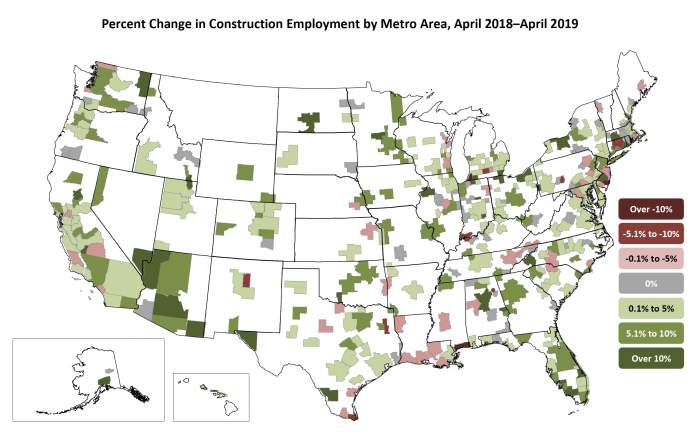Construction employment in the Chicago-Naperville-Arlington Heights area increased by one percent in the year ending April, 2019, resulting in a growth of 700 workers on the previous level of 129,000, according to US labor department data compiled by the Associated General Contractors of America (AGCA).
Generally, regions within the state (and Illinois border state metropolitan areas) fared in the middle to lower levels, compared to other regions nationally.
There were pockets of high growth, such as the area ofDavenport-Moline-Rock Island, IA-IL, which saw an 11 percent increase (with logging and mining included) to 10,800 workers, from 9,700 in 2018 — ranking the area as the 18th fastest growing nationally, percentage wise.
On the other end of the spectrum, employment dropped in Bloomington by four percent (or 100 workers); from 2,800 to 2,700 — giving it a ranking of 333.
See data for other Illinois communities below:
Listings include in order the community name, the number of jobs in April 2018, April 2019 employment, the percentage increase (decrease), net change in employment, and national ranking.
- St. Louis, MO-IL Mining, Logging, and Construction 65,800 71,500 9% 5,700 35
- Lake County-Kenosha County, IL-WI Div. Construction 15,100 16,300 8% 1,200 46
- Decatur, IL Mining, Logging, and Construction 2,800 3,000 7% 200 66
- Champaign-Urbana, IL Mining, Logging, and Construction 3,400 3,600 6% 200 84
- Elgin, IL Div. Construction 13,100 13,600 4% 500 148
- Rockford, IL Mining, Logging, and Construction 5,100 5,300 4% 200 148
- Springfield, IL Mining, Logging, and Construction 3,800 3,900 3% 100 169
- Chicago-Naperville-Arlington Heights, IL Div. Construction 129,000 129,700 1% 700 225
- Danville, IL Mining, Logging, and Construction 500 500 0% 0 251
- Kankakee, IL Mining, Logging, and Construction 1,200 1,200 0% 0 251
- Peoria, IL Mining, Logging, and Construction 7,300 7,300 0% 0 251
Nationally, construction employment grew in 250 out of 358 metro areas between April 2018 and April 2019, declined in 53 and was unchanged in 55, AGCA officials said, adding that construction employment in many parts of the country likely would have been higher if firms could find more qualified workers to hire.
“Demand for construction is steady or rising in most parts of the country, and many contractors are adding workers when they can find them,” said Ken Simonson, the association’s chief economist. “At the same time, many firms report they would have hired even more employees if only they could find enough qualified workers.”
The Phoenix-Mesa-Scottsdale, Ariz. metro area added the most construction jobs during the past year (16,600 jobs, 14 percent). Other metro areas adding a large amount of construction jobs during the past 12 months include Dallas-Plano-Irving, Texas (9,200 jobs, 6 percent); Atlanta-Sandy Springs-Roswell, Ga. (7,000 jobs, 6 percent) and Las Vegas-Henderson-Paradise, Nev. (6,800 jobs, 11 percent). The largest percentage gain occurred in Monroe, Mich. (26 percent, 500 jobs) and St. Cloud, Minn. (26 percent, 1,500 jobs), followed by Auburn-Opelika, Ala. (25 percent, 600 jobs) and Norwich-New London-Westerly, Conn.-R.I. (16 percent, 600 jobs).
The largest job losses between April 2018 and April 2019 occurred in Charlotte-Concord-Gastonia, N.C.-S.C. (-2,600 jobs, -4 percent), followed by Baton Rouge, La. (-1,800 jobs, -3 percent); Hartford-West Hartford-East Hartford, Conn. (-1,600 jobs, -8 percent) and Longview, Texas (-1,300 jobs, -9 percent). The largest percentage decrease took place in Gulfport-Biloxi-Pascagoula, Miss. (-13 percent, -1,200 jobs) and Atlantic City-Hammonton, N.J. (-13 percent, -800 jobs), followed by Niles-Benton Harbor, Mich. (-12 percent, -300 jobs); Evansville, Ind.-Ky. (-9 percent, -1,000 jobs) and Longview, Texas.
Association officials said that even though construction employment continues to expand in many parts of the country, workforce shortages remain problematic for many contractors eager to keep pace with strong demand. They urged federal officials to boost investments in career and technical education and to enact immigration reform that allows more men and women with construction skills to legally enter the country. They also urged state and local education officials to establish more school programs that offer exposure to essential construction skills.
“One reason relatively few young adults choose to pursue rewarding careers in construction is because not many of them are being told it is an option to consider,” said Stephen E. Sandherr, the association’s chief executive officer. “We have a lot of contractors looking for workers so they can keep up with the amount of work that is out there.”
View the metro employment rankings and map.






